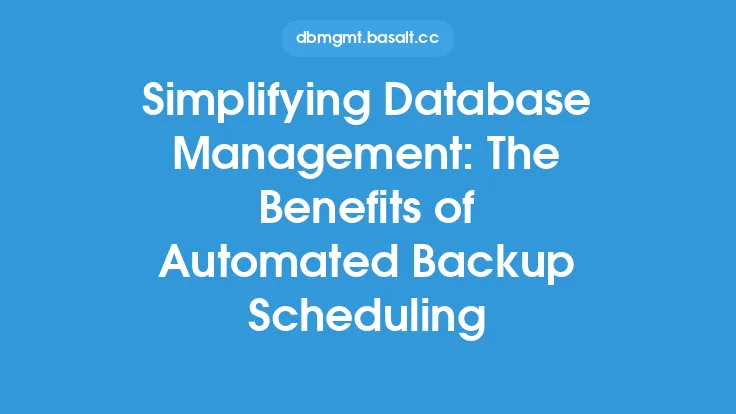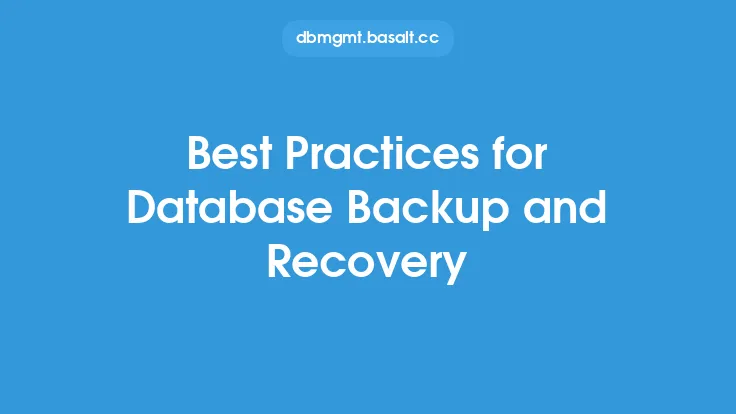Database backup and recovery is a critical aspect of database management, as it ensures the integrity and availability of data in the event of a failure or disaster. One of the key components of a robust database backup and recovery strategy is automated scheduling and automation techniques. By streamlining database backup and recovery with automated scheduling and automation techniques, organizations can minimize downtime, reduce the risk of data loss, and improve overall database performance.
Introduction to Automated Scheduling
Automated scheduling is the process of using software or scripts to schedule database backups at regular intervals, without the need for manual intervention. This can be done using a variety of tools and techniques, including cron jobs, SQL scripts, and commercial backup software. Automated scheduling provides several benefits, including improved consistency, reduced administrative overhead, and enhanced reliability. By automating the backup process, organizations can ensure that backups are performed regularly, without the risk of human error or forgetfulness.
Automation Techniques for Database Backup
There are several automation techniques that can be used to streamline database backup and recovery, including scripting, batch processing, and real-time replication. Scripting involves using programming languages, such as Python or Perl, to automate the backup process. Batch processing involves using software to automate the backup process in batches, rather than individually. Real-time replication involves replicating data in real-time, to ensure that backups are always up-to-date. These techniques can be used alone or in combination, to provide a robust and reliable database backup and recovery strategy.
Benefits of Automated Scheduling and Automation Techniques
The benefits of automated scheduling and automation techniques for database backup and recovery are numerous. These include improved consistency, reduced administrative overhead, enhanced reliability, and minimized downtime. Automated scheduling and automation techniques can also help to reduce the risk of data loss, by ensuring that backups are performed regularly and consistently. Additionally, automated scheduling and automation techniques can help to improve overall database performance, by reducing the load on the database during backup operations.
Best Practices for Implementing Automated Scheduling and Automation Techniques
There are several best practices that organizations should follow when implementing automated scheduling and automation techniques for database backup and recovery. These include developing a comprehensive backup strategy, selecting the right automation tools, testing and validating backups, and monitoring and maintaining the backup process. Organizations should also ensure that backups are stored securely, and that access to backups is restricted to authorized personnel. By following these best practices, organizations can ensure that their database backup and recovery strategy is robust, reliable, and effective.
Common Challenges and Considerations
There are several common challenges and considerations that organizations should be aware of when implementing automated scheduling and automation techniques for database backup and recovery. These include ensuring data integrity, managing backup storage, and handling backup failures. Organizations should also consider the impact of automated scheduling and automation techniques on database performance, and take steps to minimize any negative impacts. Additionally, organizations should ensure that their automated scheduling and automation techniques are compliant with relevant regulations and standards, such as GDPR and HIPAA.
Future of Automated Scheduling and Automation Techniques
The future of automated scheduling and automation techniques for database backup and recovery is likely to be shaped by emerging trends and technologies, such as cloud computing, artificial intelligence, and machine learning. These technologies are likely to provide new opportunities for automating and streamlining database backup and recovery, and for improving the reliability and effectiveness of database backup and recovery strategies. Organizations should stay up-to-date with these emerging trends and technologies, and be prepared to adapt their database backup and recovery strategies accordingly.
Conclusion
In conclusion, automated scheduling and automation techniques are critical components of a robust database backup and recovery strategy. By streamlining database backup and recovery with automated scheduling and automation techniques, organizations can minimize downtime, reduce the risk of data loss, and improve overall database performance. Organizations should follow best practices for implementing automated scheduling and automation techniques, and be aware of common challenges and considerations. As emerging trends and technologies continue to shape the future of database backup and recovery, organizations should stay up-to-date and be prepared to adapt their strategies accordingly. By doing so, organizations can ensure that their database backup and recovery strategy is robust, reliable, and effective, and that their data is always available and accessible.





